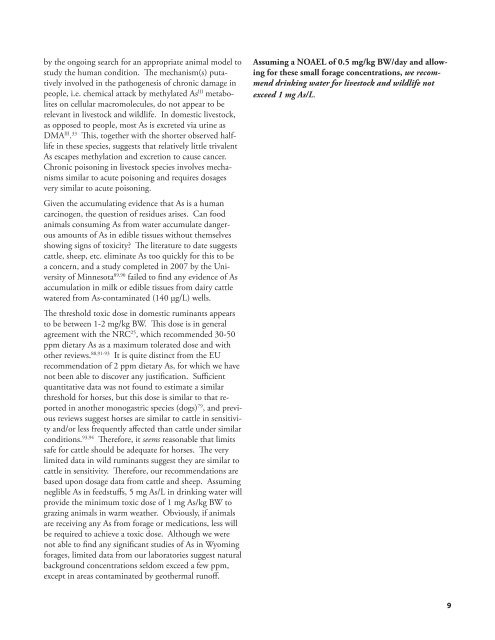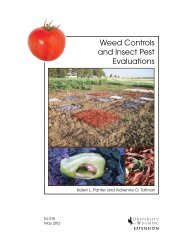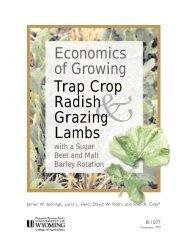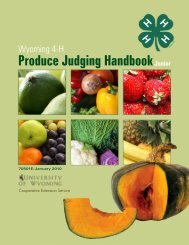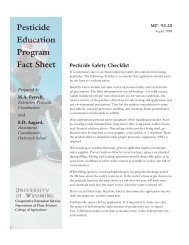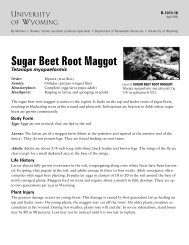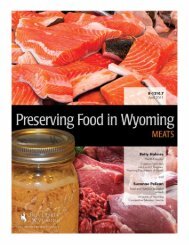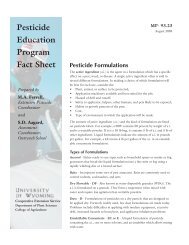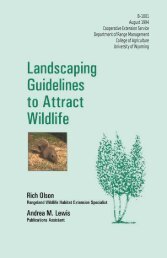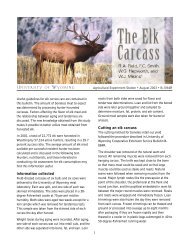in diseases such as cancer. 10,20,23,32,33,41,44 Dimethylarsinicacid (DMA V ) and monomethylarsonoic acid (MMA V )are the main urinary metabolites of As excreted in mostmammals; however, the trivalent As metabolites, dimethylarsinousacid (DMA III ), and monomethylarsonousacid (MMA III ) have been discovered in fresh urine of Aspoisonedhuman patients. 20 The glutathione conjugateof DMA III was actually more toxic to cells in vitro thaninorganic As 20 , and DMA III causes single-strand breaks inDNA in vitro. 20,75 These processes are apparently limitedto human beings and specialized laboratory models; thus,based upon known differences in metabolism, this class ofdisease and dosages does not seem relevant <strong>for</strong> livestockand big game animals.Developmental studies of orally administered MMA V andDMA V (the metabolites of inorganic As in most nonhumanmammals) in rats and rabbits determined thethreshold of fetal damage was similar to that <strong>for</strong> maternaltoxicity or about 36 and 48 mg/kg BW, respectively. 76Administration of As by gavage to pregnant rats and micedid not produce morphologically evident teratogenesis atnon-maternally toxic dosages, although there was someevidence of behavioral changes in pups born to damsconsuming drinking water with slightly less As III than thelowest maternally toxic dose. 22 Conversely, Domingo 77reported that As III , via the oral route of exposure, wasmuch less teratogenic in several species. This indicatesthat dietary limits safe <strong>for</strong> a dam should also provideadequate protection <strong>for</strong> her fetus.There are very few reports of chronic toxicity in non-rodentanimals. Due to the rapid excretion of As in cattle,sheep, dogs, etc., these species are able to clear less-thanacutely-toxicdoses of As be<strong>for</strong>e they can cause much ofa problem. 25,78 The reports of chronic toxicity we discoveredinvolved dosages similar to those reported <strong>for</strong> acuteor subacute poisoning. Female beagle dogs fed 4 to 8 mgNaAsO 2(2.3-4.6 mg As)/kg BW per day <strong>for</strong> 183 daysexhibited decreased weight gains due to decreased feedconsumption and slightly elevated liver enzymes. 79 Beagledogs were fed varying concentrations of As as eitherAs III or As V <strong>for</strong> two years. At 50 ppm and less, there wereno measurable effects. At 125 ppm dietary As, the dogslost weight and several died with lesions of inanition. 80Three of four sheep given 88 mg PbHAsO 4/kg BW onceper month died within 24 hours of the seventh dose. Theother sheep in the study, given 22 and 44 mg PbHAsO 4(4.9 and 9.7 mg As/kg BW), survived 11 doses with noclinical signs. 54 One of two lambs dosed with 1.5 mg As/kg BW/day as PbHAsO 4died after 35 days; the othersurvived until the study was stopped at 94 days. 62 Sheepfed a mean daily dose of 1.4 mg As/kg (As species unspecified)<strong>for</strong> three weeks remained in good condition <strong>for</strong>the duration of the study. 81 Bucy et al. 82 fed potassiumarsenite to feedlot lambs at doses as high as 3.26 mg As/kg BW/day <strong>for</strong> eight weeks without adverse effects. In alater study 1.75 mg/kg BW/day was not toxic, but higherdoses caused feed refusal and clinical signs of toxicity. 83Peoples 78 added arsenic acid to dairy rations at 1.25 ppm,a dose of approximately 0.48 mg As/kg BW/day <strong>for</strong> sevenweeks with no effects. Virtually all of the ingested As waseliminated as quickly as it was eaten.It has been proposed 84 that elk in the Madison-Fireholewatershed of Yellowstone National Park have shorterlifespans because of naturally elevated As in water andfeedstuffs. Exposure was estimated to be “greater than1.25 mg/kg BW/day” based upon tissue concentrationsand extrapolation from bovine studies and between “0.01- 6.2 mg/kg BW/day” based upon <strong>for</strong>age and water analysis.The difference in longevity also may be due to otherenvironmental differences between the Madison-Fireholearea and the control site. 84 Forsberg et al. 85 demonstratedslight but measurable inhibition of normal rumenfermentation in vitro with As concentrations as low as 5mg/L of rumen fluid, but they did not provide any dataas to how this concentration related to dietary intake.Assuming <strong>for</strong> the moment that the rumen fluid concentrationis equivalent to the combined concentrations infeed and water, the concentration would be equivalent toa dose of roughly 1 mg As/kg BW.SummaryOur recommendations are based upon the toxicity of inorganicAs III , specifically the arsenite ion. Routine waterquality analysis available to livestock producers does notdistinguish between As species, and, although the lesstoxic pentavalent <strong>for</strong>ms of As are more likely to occurin surface waters, trivalent As is seen frequently enoughin specialized surveys to justify the assumption. 86,87 It issuggested that ruminant animals are less susceptible to Asthan monogastrics. 25,88 With the exception of laboratoryrodents, however, we were not able to confirm this to bethe case, thus we have assumed horses are equally sensitiveto As as ruminants.Chronic poisoning of the type (cancer, “blackfoot disease,”etc.) that prompted lowering the human drinkingwater standard from 0.05 to 0.01 mg As/L does notapparently occur in other animal species, as demonstrated8
y the ongoing search <strong>for</strong> an appropriate animal model tostudy the human condition. The mechanism(s) putativelyinvolved in the pathogenesis of chronic damage inpeople, i.e. chemical attack by methylated As III metaboliteson cellular macromolecules, do not appear to berelevant in livestock and wildlife. In domestic livestock,as opposed to people, most As is excreted via urine asDMA III . 33 This, together with the shorter observed halflifein these species, suggests that relatively little trivalentAs escapes methylation and excretion to cause cancer.Chronic poisoning in livestock species involves mechanismssimilar to acute poisoning and requires dosagesvery similar to acute poisoning.Given the accumulating evidence that As is a humancarcinogen, the question of residues arises. Can foodanimals consuming As from water accumulate dangerousamounts of As in edible tissues without themselvesshowing signs of toxicity? The literature to date suggestscattle, sheep, etc. eliminate As too quickly <strong>for</strong> this to bea concern, and a study completed in 2007 by the Universityof Minnesota 89,90 failed to find any evidence of Asaccumulation in milk or edible tissues from dairy cattlewatered from As-contaminated (140 μg/L) wells.The threshold toxic dose in domestic ruminants appearsto be between 1-2 mg/kg BW. This dose is in generalagreement with the NRC 25 , which recommended 30-50ppm dietary As as a maximum tolerated dose and withother reviews. 88,91-93 It is quite distinct from the EUrecommendation of 2 ppm dietary As, <strong>for</strong> which we havenot been able to discover any justification. Sufficientquantitative data was not found to estimate a similarthreshold <strong>for</strong> horses, but this dose is similar to that reportedin another monogastric species (dogs) 79 , and previousreviews suggest horses are similar to cattle in sensitivityand/or less frequently affected than cattle under similarconditions. 93,94 There<strong>for</strong>e, it seems reasonable that limitssafe <strong>for</strong> cattle should be adequate <strong>for</strong> horses. The verylimited data in wild ruminants suggest they are similar tocattle in sensitivity. There<strong>for</strong>e, our recommendations arebased upon dosage data from cattle and sheep. Assumingneglible As in feedstuffs, 5 mg As/L in drinking water willprovide the minimum toxic dose of 1 mg As/kg BW tograzing animals in warm weather. Obviously, if animalsare receiving any As from <strong>for</strong>age or medications, less willbe required to achieve a toxic dose. Although we werenot able to find any significant studies of As in <strong>Wyoming</strong><strong>for</strong>ages, limited data from our laboratories suggest naturalbackground concentrations seldom exceed a few ppm,except in areas contaminated by geothermal runoff.Assuming a NOAEL of 0.5 mg/kg BW/day and allowing<strong>for</strong> these small <strong>for</strong>age concentrations, we recommenddrinking water <strong>for</strong> livestock and wildlife notexceed 1 mg As/L.9
- Page 1 and 2: Water Qualityfor Wyoming Livestock
- Page 3: AbbreviationsADG - average daily ga
- Page 6 and 7: 7 pH 31Function. . . . . . . . . .
- Page 8 and 9: animal drinks. Water intake is tech
- Page 10 and 11: ter or “mg X/L”. If the substan
- Page 12 and 13: tion between the erythrocytic and p
- Page 17 and 18: 3 BariumBarium (Ba), an alkaline ea
- Page 19 and 20: exposed to 100 mg Ba 2+ /L had depr
- Page 21 and 22: 4 FluorideFluorine (F) is the most
- Page 23 and 24: lost weight and many died at the hi
- Page 25: Our search of the literature pertai
- Page 28 and 29: elatively stable; however, once unb
- Page 30 and 31: supplementing with 17 ppm Cu for si
- Page 32 and 33: not transport oxygen from the lungs
- Page 34 and 35: Winter and Hokanson 381 fed varying
- Page 37 and 38: 7 pHpH is defined as “the negativ
- Page 39: for basic drinking water. From a pu
- Page 42 and 43: efficiency. 436,437 Absorption of S
- Page 44 and 45: significantly impaired in the same
- Page 47 and 48: 9 Sodium ChlorideSodium chloride (N
- Page 49 and 50: containing 15,000 mg NaCl/L for 21
- Page 51 and 52: 10 SulfurSulfur (S) occurs in natur
- Page 53 and 54: in feed or water consumption. The a
- Page 55 and 56: 11 Total Dissolved Solids (TDS)Tota
- Page 57: 12 SummaryElementShort (days - week
- Page 61 and 62: 14 Bibliography1. National Research
- Page 63 and 64: 35. Klug H.L., Lampson G.P. and Mox
- Page 65 and 66:
69. Harding J.D., Lewis G. and Done
- Page 67 and 68:
104. Choudhury H. and Cary R. (2001
- Page 69 and 70:
136. Boyd E.M. and Abel M. (1966).
- Page 71 and 72:
171. Mullenix P.J., Denbesten P.K.,
- Page 73 and 74:
203. Schultheiss W.A. and Van Nieke
- Page 75 and 76:
237. Tolgyesi G. and Elmoty I.A. (1
- Page 77 and 78:
269. ANZECC (2000). Australian and
- Page 79 and 80:
301. Huber J.T., Price N.O. and Eng
- Page 81 and 82:
332. Crowley J.W., Jorgensen N.A.,
- Page 83 and 84:
366. Walker R. (1990). Nitrates, ni
- Page 85 and 86:
399. Wu L., Kohler J.E., Zaborina O
- Page 87 and 88:
432. Naftz D.L. and Rice J.A. (1989
- Page 89 and 90:
464. Glenn M.W., Jensen R. and Grin
- Page 91 and 92:
498. Knott S.G. and McCray C.W.R. (
- Page 93 and 94:
532. Harvey R.W., Croom J. WJ, Pond
- Page 95 and 96:
567. Koletsky S. (1959). Role of sa
- Page 97 and 98:
602. Gooneratne S.R., Olkowski A.A.
- Page 99 and 100:
633. McAllister M.M., Gould D.H., R


